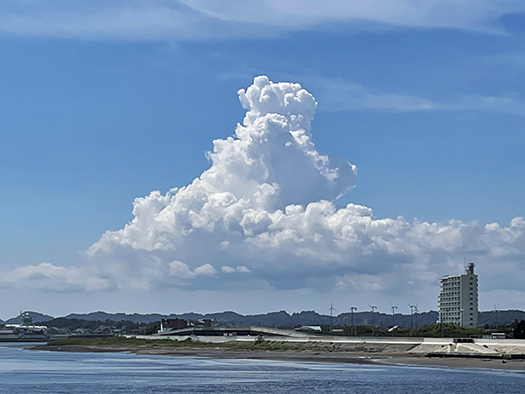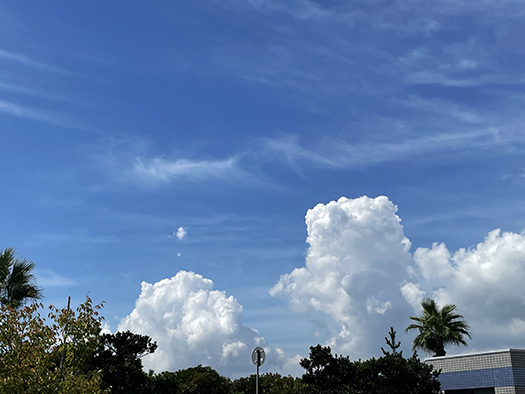
その土地のことが肌身でわかる、理解できるひとつの象徴的なものとして、雲の様子というものがあるのではないかなぁと思っています。ヘンなんですが(笑)人間、子どもの時には、ごく天然で日々「雲と追いかけっこ」しながら毎日を過ごすのではないでしょうか。
あんまり科学的に捉えたことはないのですが、ググると以下のような答え。
〜①上昇気流のあるところで空気が上に持ち上げられる。②上空に持ち上げられた空気は冷やされる。
100メートルで約1℃ほど冷える。 ③ 冷やされると空気の中の水蒸気が水や氷の粒になって雲ができる。この水分が空気中の小さな「ちり」などの周りに集まり,水滴や氷の粒となる。この粒は0.02mmから0.2mmと小さいけれど,これが集まって雲の形を作っている。〜
で、わたしは北海道生まれなので3才まで過ごしていた土地、一時期を除いて少年期から過ごしている札幌という「定点観測」の土地がある。幼年期の雲の記憶はそう強烈ではないけれど、それでもいっとき生まれ故郷に留まっていることがあると意識下の「なつかしさ」の機縁になっていたりする。
札幌は20-30kmほど離れている石狩川に添って雲が動いている様子が自然に記憶に刷り込まれている。北側の空に浮かんでいる雲たちがいろんな情報を語りかけてくれる存在だった。「嵐が来るぞ、暑くなるぞ」
そんな雲たちとの風土記憶を表現したコトバとして「坂東太郎」というコトバが好きです。

〜[1] (坂東にある第一の川の意) 関東地方を流れる利根川の異称。※随筆・東路記(1685年)江戸より日光へ行道の記「坂東第一の大河なり。故に此あたりの人は坂東太郎と云ふ」[2](利根川の方向に生ずるところから) 夏の白雲をいう。※物類称呼(1775年)一「なつのくも 江戸にて、坂東太郎と云ふ」〜
そもそも板東というのもヤマトタケルの東方遠征の時期に関東を振り返って見る「坂」の途上から東方を見たときの故事にちなんでいる古称とのこと。いかにも語感としてバンドウというのは、やんちゃな子どもの天然ぶりが表現されているようで、その地域性格がまんま板東武者という日本史の主導力にもなっていったのか。
利根川の暴れっぷりとも重なり、土地の空気感が雲のカタチとして表現されているかのよう。
東京では空が小さくなってきているので、あんまり実感できないけれど、広大な関東平野地形に来れば、夏の季節の表現として、視覚的に人のこころにまっすぐ突き刺さってくる。
写真は千葉の九十九里にほど近い場所で見上げていた光景。
関東平野に、広大無辺な太平洋から温度上昇した気団が吹き付けてきて、こうした海洋民族的光景・景観を生み出すのでしょう。広い平野部が日射を受けて気温上昇して水蒸気を上昇させ、関東地域らしい微細な土塊にからみついて結晶される。こうしたさまざまな風土条件が雲のカタチを生んでいくのでしょうね。
どうもはじめて見てから、ずっと好きであり続けています。告白でした(笑)。
English version⬇
[I like you, Taro Bando (laughs).
The vast Kanto Plain and the raging river, Tone River, and the naughty boys generated by the Pacific Ocean’s oceanic air mass rushing into it. Is it also a prime expression of the oceanic race? …
I think that one of the symbolic things that allows us to understand the local area firsthand is the appearance of clouds. I know it sounds strange (laugh), but I think that when we are children, we naturally spend our days “chasing after clouds”.
I have never really taken a scientific view of it, but a quick google search gave me the following answer.
~1) Air is lifted upward where there is an updraft. (2) Air lifted upward is cooled.
It cools about 1 degree Celsius at 100 meters. (3) As it cools, the water vapor in the air turns into water or ice particles and clouds form. This moisture collects around small “dust” in the air and forms water droplets and ice particles. These particles are as small as 0.02 mm to 0.2 mm, but they gather together to form clouds. 〜I was born in Hokkaido, Japan, so I am a native of Hokkaido, Japan.
I was born in Hokkaido, so I have a “fixed point of observation” in Sapporo, where I lived until I was 3 years old and where I have lived since I was a boy, except for a period of time. Although my childhood memories of clouds are not so strong, I still feel a sense of nostalgia when I stay in my birthplace for a while.
In Sapporo, the clouds moving along the Ishikari River, which is about 20 to 30 km away from the city, are naturally imprinted in my memory. Clouds floating in the northern sky were a source of various information. Storms are coming, it’s going to be hot.
I like the phrase “Bando Taro” as a phrase that expresses my climate memory with such clouds.
〜[1] (meaning “the first river in Bando”) A variant name for the Tone River, which flows through the Kanto region. Zuishu, Toji-ki (1685), an account of a journey from Edo to Nikko: “It is the first great river in Bando. It is the largest river in the Bando region, so people around here call it Bando Taro.”[2] (From its origin in the direction of the Tone River) A term for white clouds in summer. In the first place, the name “Bando” is also used to refer to the Yamatotake mushrooms, which are also called “yamatake” in Japanese.
Bando is also an ancient name that comes from the legend of Yamatotakeru’s expedition to the east, when he looked back to the Kanto region and saw the east from the “slope” of the hill. The word “Bando” seems to express the natural behavior of a mischievous child, and the local character of the area became the leading force in Japanese history, just as it was called “Bando Bussha.
The atmosphere of the land seems to be expressed in the form of clouds, which also overlap with the rampaging Tone River.
In Tokyo, the sky is getting smaller and smaller, so we cannot really feel it, but if we come to the vast Kanto Plain, it will visually pierce our hearts as an expression of the summer season.
The photo shows a view from a place near Kujukuri in Chiba.
The Kanto Plain is probably blown by air masses with rising temperatures from the vast and boundless Pacific Ocean, creating this kind of maritime ethnic scene and landscape. The broad plains receive solar radiation, which raises temperatures and raises water vapor, which crystallizes as it clings to the fine clumps of soil typical of the Kanto region. These various climatic conditions must give birth to the shape of the clouds.
Thanks, I have been in love with it ever since I saw it for the first time. That was a confession (laughs).
Posted on 9月 16th, 2023 by 三木 奎吾
Filed under: 未分類







コメントを投稿
「※誹謗中傷や、悪意のある書き込み、営利目的などのコメントを防ぐために、投稿された全てのコメントは一時的に保留されますのでご了承ください。」
You must be logged in to post a comment.